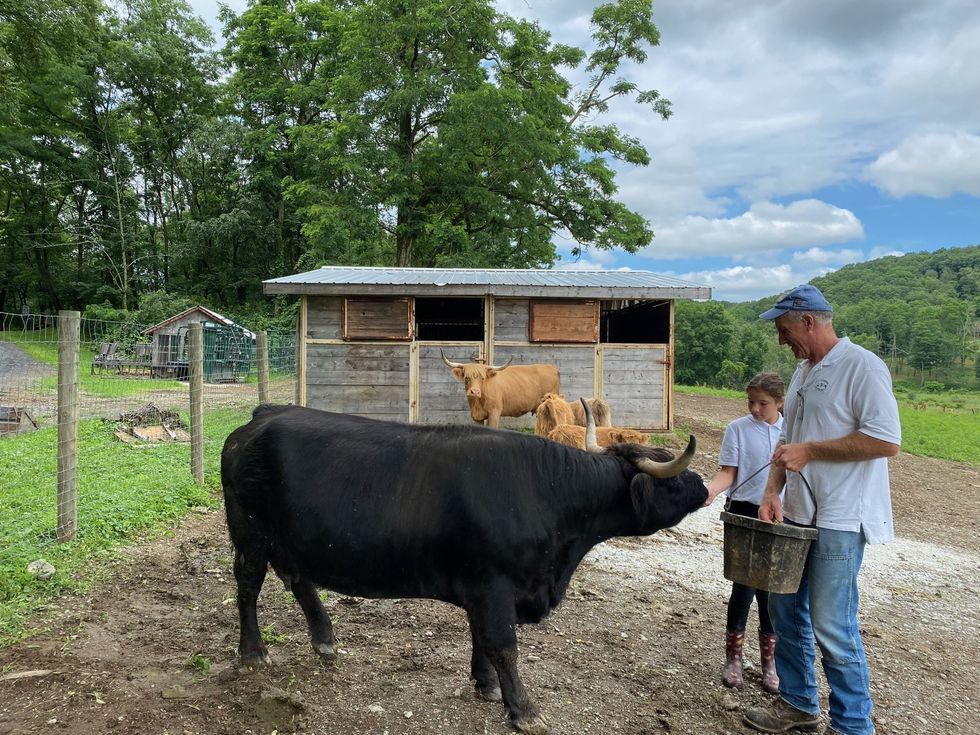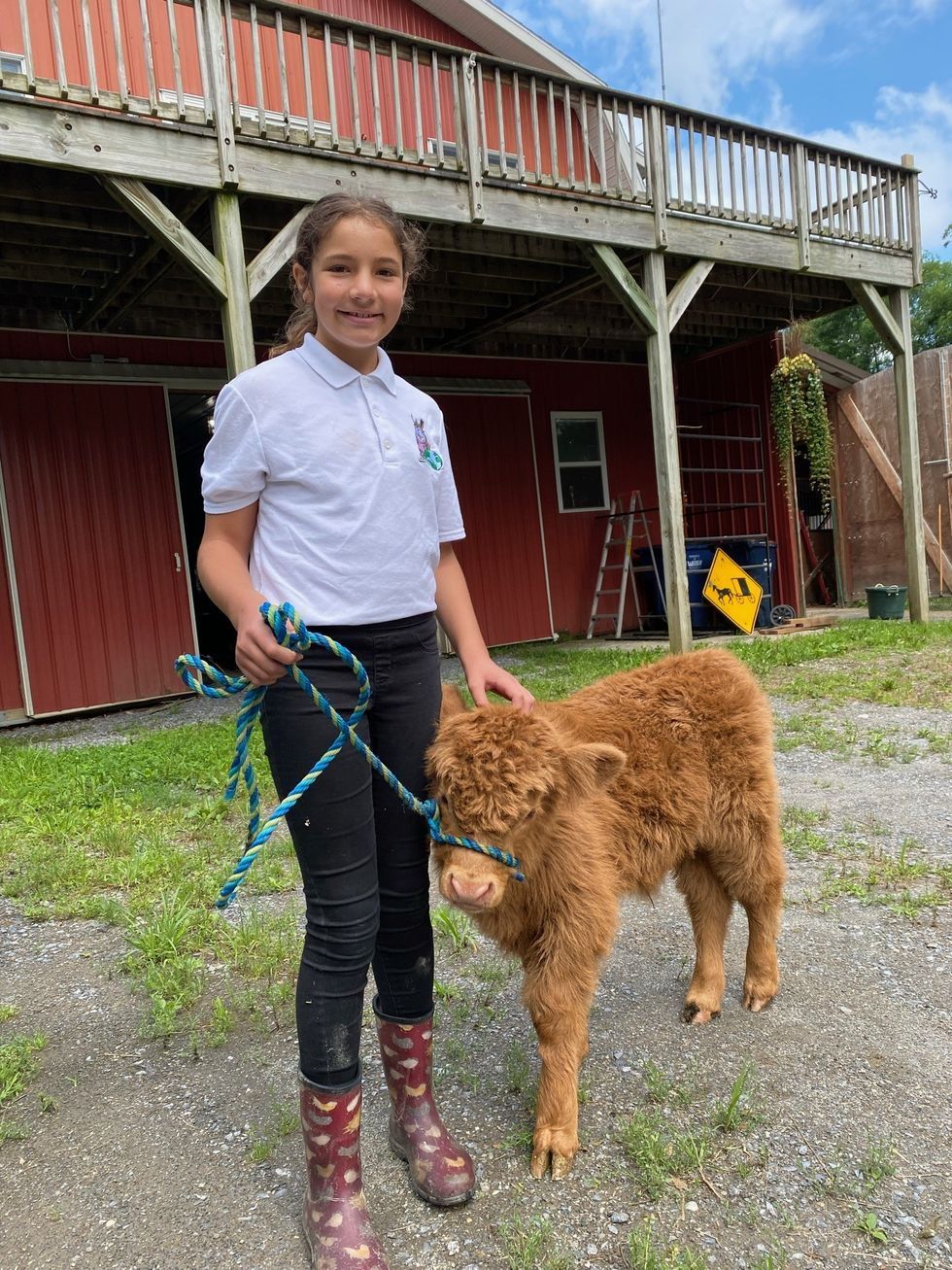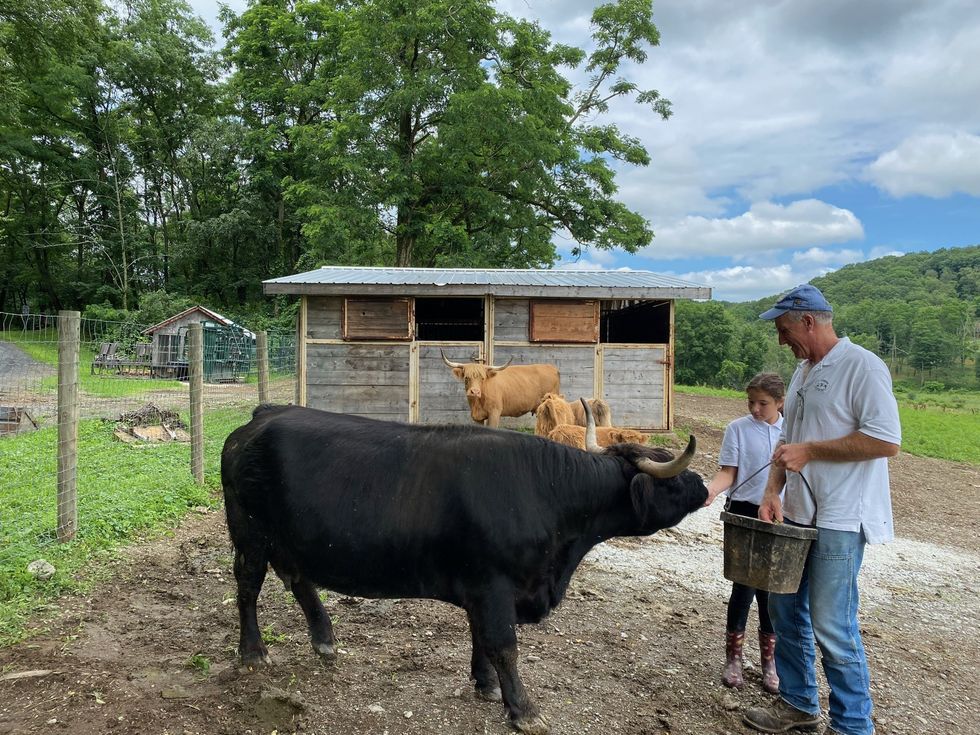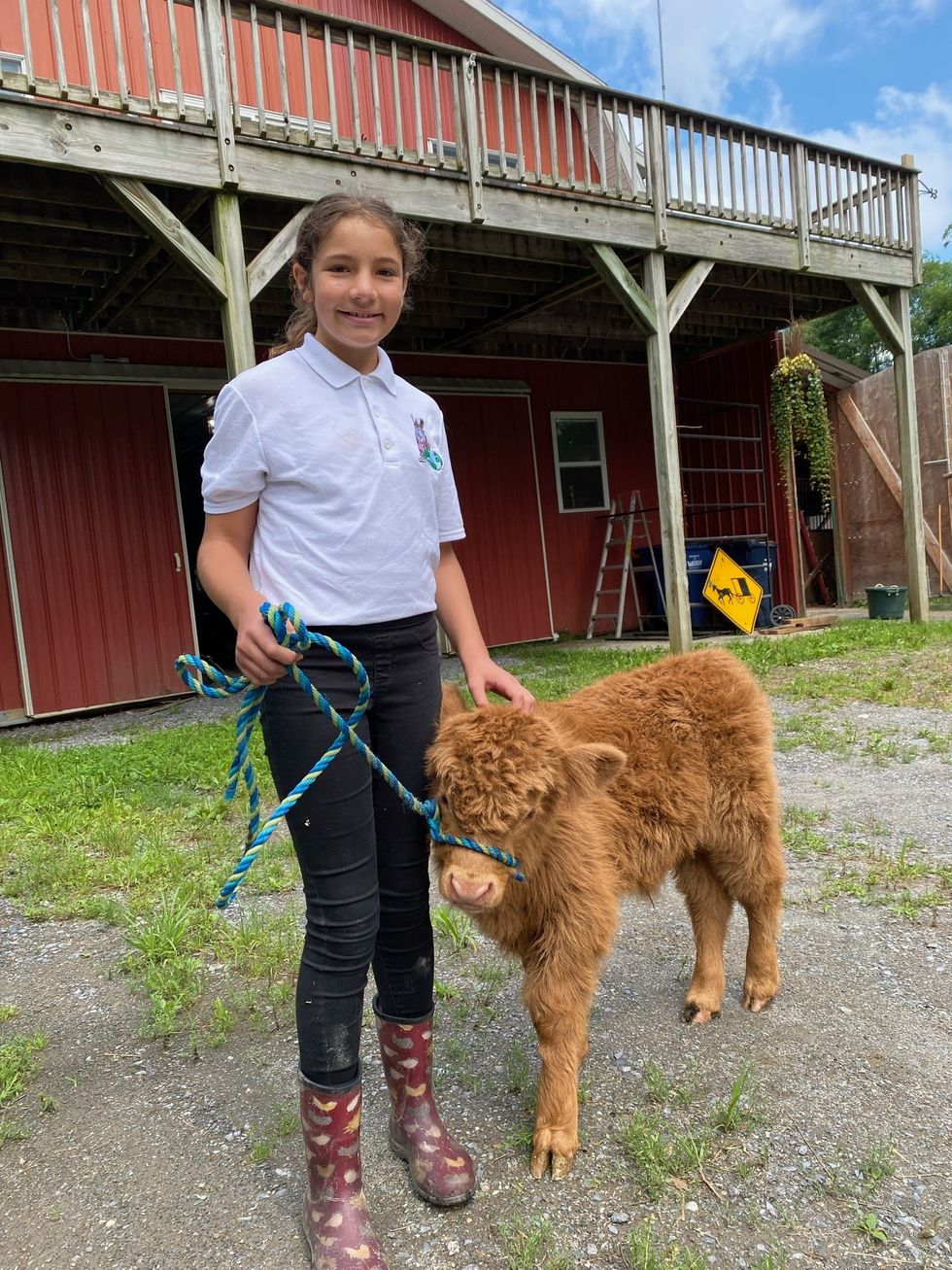Latest News
A Reporter’s Career Day
Apr 17, 2024
Senior Reporter Patrick Sullivan shared tales from a career in journalism for Career Day at Sharon Center School, April 11.
Provided
SHARON — I was a guest speaker at Sharon Center School’s Career Day on Thursday, April 11.
For a week prior I carefully rehearsed and refined my remarks. I made careful notes.
Then I forgot to bring them.
I did remember my props. To wit, a pile of back issues of The Lakeville Journal and two stacks of Real Official Reporters Notebooks, as endorsed by H.L. Mencken, Woodward and Bernstein, and Clark Kent.
There were about a dozen of us. I knew Tom Bartram, who was representing the Sharon fire department along with Nikki Blass, Beth Klippel and Quentin Leibrock. Also on hand were Adam Smith, art sculptorist; Ashley Coon, formulation engineer; Sarah Coon, Owner of Paley’s Gardens; Zachary Rodriguez, electrician and Devon Sheehan, Sharon Center School nurse/hospital nurse.
At the appropriate moment we were herded into the gym/auditorium so the students could get a good look at us, and then it was off to the classrooms.
We each had three groups of six or eight students in rotation, each for about 15 minutes.
It’s a bit of a blur, but I explained what the Journal is, how I came to work for the paper, how we go about putting the paper together, how the seasoned reporter operates, and answered questions.
I found the way the middle school girls stared at me completely unnerving. As if they couldn’t quite believe it.
But as a whole the students were polite and engaged, asked good questions and even followed up a couple times.
One student asked how I became a reporter and received the unorthodox answer (“by accident”) with aplomb.
Another asked if a degree in journalism is required. Feeling diplomatic, I suggested that working on a newspaper — any newspaper — is the best way to learn the craft.
Good thing I brought the notebooks. That and the subsequent note taking advice chewed up five minutes easy.
The advice part went something like this:
Me: You should type or rewrite your notes as soon as possible after the class or event, before you forget what they mean. (Show page of old notebook to students.) Can you read that?
Students: No.
Me: Me neither. And I wrote it!
It’s been a long time since I stood before a classroom to impart Knowledge [sic on the capital K]. I admit to being a little rusty.
But by the third time through I was ready to take on all comers. Unfortunately, Career Day was over.
On the way out I thanked my host, School Counselor Elizabeth Foster, and reminded her that Lakeville Journal Managing Editor Riley Klein is much younger, considerably taller and overall a vastly better choice for such activities in the future.
Keep ReadingShow less
Turning Back the Pages
Apr 17, 2024
100 years ago – April 1924
The nuisance of needless noise from automobiles is sharply dealt with in Document 15 of the Motor Vehicle Department, especially the practice of tooting at intersections to signify plan to hold speed and grab right of way, instead of slowing down and using eyes. Similar abuses are calling people with the horn, tire chains slapping, brakes shrieking, etc. All unnecessary noise is illegal and subject to fine.
The last of the ice left the lake on Tuesday, a somewhat later date than usual.
Daylight saving in New York and Massachusetts goes into effect on Sunday, April 27th. This state does not recognize daylight saving as regards the changing of the clocks, but many towns along railroads will of necessity change their hours of business to conform to the changing of train schedules.
John Eggleston of Lime Rock is having his house wired for electricity.
Some of the residents of Lime Rock Road decided the other day that enough cars had been stuck in the quagmire between the main road and the railroad, and took a hand in draining it. Judge Landon, among others, turned to with a shovel. Ridges were broken down and the stuff was thrown into the ruts, driving off the water, which was guided down the newly-opened gutters. Drains under the road, clogged for years, were cleaned out or rebuilt. Fresh gravel was drawn into the worst of the holes, both there and further down the road. The town scraper finished the job and Lime Rock Road is now navigable without sails or paddles.
50 years ago – April 1974
Astonishment and doubt continue to reverberate throughout Northwestern Connecticut, nearly one week after the Superior Court jury convicted Peter A. Reilly of first-degree manslaughter for the September slaying of his mother, Barbara Gibbons. The unanimous guilty verdict by five women and seven men was announced Friday afternoon after more than nine hours of deliberation spanning two days. The trial began March 1.
A handful of angry and worried horse-owners from Canaan and Salisbury stormed a closed-door session of the Connecticut Equine Advisory Council in Hartford Tuesday night in an effort to block an animal medical research center from being moved from New Jersey into Canaan. The Animal Medical Center, which has been doing research on equine infectious anemia, wishes to bring 50 of its test animals to the former Segalla Stables in Greenacres. The horse owners fear that EIA, which is a fatal disease readily transmitted by flies, mosquitoes and other biting insects, will find its way into the area’s horse population from the infected stock. Connecticut has the densest horse population in the country.
A black leather wallet belonging to the deceased Barbara Gibbons, which was reportedly stolen before her death, was found approximately six weeks after she was brutally killed Sept. 28. It was found in tall grass, about 400 yards south of the Gibbons house, some 30 feet from Route 63, and encrusted with mud. Police reportedly investigated the robbery at the time, but it is not known what the police learned.
The Housatonic Valley Regional High School Board voted last Thursday to use surplus funds from this year’s budget to buy outright a computer the math department has been using on a lease-purchase arrangement. The move will cost over $8,000, but will save over $5,000, the board said, thanks to state reimbursement and savings on annual payments.
25 years ago – April 1999
LAKEVILLE – Friends and family of Paul Nichols Jr. were shocked this week by news that the young man met his end in a raging house fire early Sunday morning. He was 29 years old. The fire began on a couch on the second floor of the Fisher Homestead on State Line Road, according to Terrence Graves, who also lived in the house. After trying to put out the fire and drag the burning couch outside, down the stairs, the couch caught on the stairwell and couldn’t be moved. Mr. Graves ran around outside to the back stairs, but the burning couch in the stairwell had a chimney effect in the old house, propelling immense heat and smoke upwards, according to Fire Marshal Mike Fitting, who lives near the house and was one of the first ones to respond. Firefighters found Mr. Nichols in the bathroom on the second floor and managed to bring him out. Emergency medical personnel went to work on him immediately, but it was too late. Mr. Fitting said the house will be demolished. Mr. Nichols was a graduate of the Lee H. Kellogg School and Housatonic Valley Regional High School in Falls Village.
NORFOLK – Illegal burning was blamed for a brush fire that covered about five acres, demanded the work of about six volunteer fire companies and resulted in extensive damage to a fire truck. Fire Marshal Richard Healy stated that the fire, reported around noon last Thursday, was the result of a grounds maintenance worker burning brush without a permit on Summer Road, a private dirt road near Doolittle Lake. The driver of the 1976 Oren pumper truck that responded told police that the truck began sliding on the muddy, narrow dirt road leading to the fire scene before hitting a tree head-on.
Items were taken from The Lakeville Journal archives at Salisbury’s Scoville Memorial Library, keeping the original wording intact as possible.
Keep ReadingShow less
A loose legal Cannon
Apr 17, 2024
Judges are the weakest link in our system of justice, and they are also the most protected. —Alan Dershowitz
Aloose legal cannon presides in the Southern District of Florida over a federal espionage case dealing with the removal of national security-related and classified documents which when sought for return and official archive storage were denied: denied they were present, denied they were anything but the personal property of a President who had just failed his re-election bid.
No need to recount here the current plethora of Trump criminal and civil cases — some tried, some with guilty verdicts — many pending. Here of interest is the peculiar, perplexing and perfidious behaviors of the US vs Trump espionage case’s presiding official Judge Aileen Cannon and her legal processes deterring public access to evidence, facts, the behaviors of a Presidential candidate. From a former President proclaiming innocence of all indictments, let’s hear it — Judge Cannon ought help Trump refute false claims if they are false– in her court.
Nominated by Trump in May of 2020, at 40 with scant trial experience, Cannon was appointed in November just days after Trump’s 2020 re-election failure with a 56-21 Senate Confirmation — 22 not voting. In 2018, Dan McGahn, then White House Counsel, boasted of the Administration’s rigorous judicial nominee interview process “… the President (is) nominating ... people who have some experience, if not expertise, in dealing with government…” However, Judge Cannon’s trial experience and lack of law expertise has been lambasted by judges and law professionals across ages, partisan alignments, and institutional positions as scant — wanting. She is deemed as possessing — by evidence of her repeat behaviors — little knowledge of the legal landscape related to national security/confidential documents and the Espionage Act along with an unceasing proneness to questionable judgements, requests, and non-rulings. Her legal and trial shortcomings have resulted in her being overturned and reprimanded by the 11th Circuit Appeals Court twice in the past year.
Cannon has recently indicated, in her briefs and calls for prosecutor and defense response, that for her a civil statute — Presidential Records Act — trumps the criminal statute Espionage Act under which the document case criminal indictments are set.
She has delayed clear pretrial rulings, clear so say key legal experts, and more alarmingly perhaps is positioning the case for her dismissal after a Jury is sworn in — precluding an appeal — if and when a date for trial is set and commenced. In Cannon’s legal career, criminal trial law was not her focus, rather she concentrated early on appeals — the appellate system — is this where her expertise lies- when, where and how to progress or block an appeal?
Cannon was “randomly” assigned THE federal espionage case of the nation’s history with the former President as plaintiff, the “luck of the draw.” Amazingly, formal qualifications for federal judges, are almost none — no age requirement, no minimal
experience — not even a requirement for legal training. Any one confirmed by the Senate as a District Judge has Article III protections of life tenure and non-reducible salaries. A District Judge is removable only by Congressional impeachment. So, liken to SCOTUS, big questions about our Judiciary: what qualifications drive judicial confirmation, what assures sustained ethical and legal behavior of Judges, and how are these positions of such powerful impact restricted in tenure and accountable for behavior? Time to do something.
The bedrock of our democracy is the rule of law and that means we have to have an independent judiciary, judges who can make decisions independent of the political winds that are blowing. — Caroline Kennedy
Kathy Herald-Marlowe lives in Sharon.
Keep ReadingShow less
loading


















